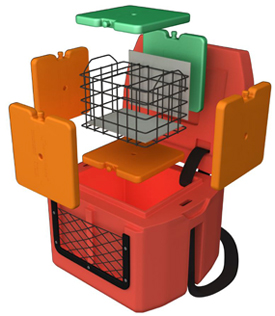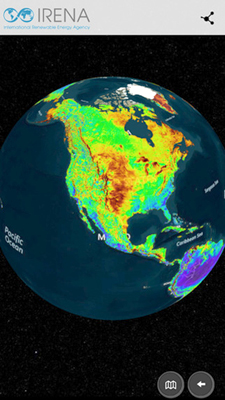 The Phase Change Matters e-mail newsletter is a weekly summary of the latest news and research on phase change materials and thermal energy storage. To subscribe, visit www.puretemp.com/subscribe. For more frequent updates, follow @puretemp on Twitter or visit the Phase Change Matters blog, www.puretemp.com/pcmatters.
The Phase Change Matters e-mail newsletter is a weekly summary of the latest news and research on phase change materials and thermal energy storage. To subscribe, visit www.puretemp.com/subscribe. For more frequent updates, follow @puretemp on Twitter or visit the Phase Change Matters blog, www.puretemp.com/pcmatters.
NEW PRODUCT
Sonoco ThermoSafe’s new Via Blood Transporter features PureTemp PCM
Sonoco ThermoSafe has introduced a new reusable container for the transport and temporary storage of red blood cells and platelets.
 The Via Blood Transporter maintains red blood cells at 1-6° Celsius for eight hours during transport and 1-10° C for the temporary storage of blood product for a minimum of 12 hours. The container is made of expanded polypropylene and features PureTemp biobased phase change material.
The Via Blood Transporter maintains red blood cells at 1-6° Celsius for eight hours during transport and 1-10° C for the temporary storage of blood product for a minimum of 12 hours. The container is made of expanded polypropylene and features PureTemp biobased phase change material.
“The Via Blood Transporter was designed in accordance with blood bank user feedback,” said Marianne Hoonakker-Kelly, Sonoco ThermoSafe business development and market manager. “Unique and innovative features such as the front platelet pouch and affixed assembly instructions not only promote compliance, transport efficiencies and minimized risk of loss due to mishandling – they ultimately promote patient safety. Given the cost pressures applied to health care systems, products like the Via Blood Transporter are critical as they ensure recommended temperature protection while preventing the waste and loss of valuable blood product.”
ENERGY STORAGE
Smarter grid could handle massive expansion of renewables, professor says
The sun shines until clouds move in or night falls. The wind blows until it doesn’t. How can utilities working to harness these sources of renewable energy account for their variability?
 The obvious answer is batteries. In a piece posted on TheConversation.com, Sean Meyn, a professor of electrical and computer engineering at University of Florida, offers another approach:
The obvious answer is batteries. In a piece posted on TheConversation.com, Sean Meyn, a professor of electrical and computer engineering at University of Florida, offers another approach:
“California plans to spend billions of dollars for batteries to even out the flow of power from solar and wind, much the way shock absorbers smooth out bumps on the road. But do they need to? Not at all!
“In my research, I’ve found that we can accommodate a grid powered 50% by renewable energy without the use of batteries.
“Systems flexible enough to accommodate the ups and downs of solar and wind production can be made by adjusting the power at millions of homes and businesses on a minute-by-minute or even second-by-second basis. This approach requires no new hardware, some control software and a bit of consumer engagement.”
RENEWABLE ENERGY
App identifies potential locations for wind, solar, hydro, geothermal projects
 The International Renewable Energy Agency‘s Web-based Global Atlas, a research tool that helps identify potential locations for wind, solar, hydro and geothermal projects, is now available as an app for mobile devices. The Global Atlas Pocket combines a thousand datasets, including 3Tier solar and wind data and GOCE gravity disturbance maps.
The International Renewable Energy Agency‘s Web-based Global Atlas, a research tool that helps identify potential locations for wind, solar, hydro and geothermal projects, is now available as an app for mobile devices. The Global Atlas Pocket combines a thousand datasets, including 3Tier solar and wind data and GOCE gravity disturbance maps.
RenewableEnergyWorld.com‘s Vince Font reports:
“Upon launch, the app pulls up a satellite view world map. Navigating to specific points on the globe can be accomplished manually via pinch and zoom or by typing the name of a location in the search box. Users can also launch their mobile device’s GPS to zero in on their current position.
“Once a geographical location has been selected, users can access a series of maps that produce visual overlays of existing renewable energy resources. Information returned includes such data as annual solar exposure and crop sustainability indexes based on average yearly rainfall. Personalized search and sharing capabilities are also included with the app, allowing a user to forward information via email and social media.”
Global Atlas Pocket is a free download for iOS, Android, Blackberry 10 and Windows Phone devices. It’s a great fit for tablets such as the iPad Air 2, but somewhat difficult to use on devices with smaller screens. And it consistently crashes on a Nexus 5 smartphone.
PCM RESEARCH
Department of Energy awards $3 million for power plant cooling research
The Electric Power Research Institute has won a $3 million award from the U.S. Department of Energy to develop a new dry-cooling technology for thermoelectric power plants.
The new technology, which uses advanced phase change materials to improve heat transfer, is designed to significantly reduce fan power consumption and steam condensation temperatures. Existing dry-cooling systems use air instead of water to cool the steam exiting a turbine and can cut water consumption by more than 90 percent.
The nonprofit organization, funded by the electric utility industry, is teaming up with Drexel University, the University of Memphis, Evapco, WorleyParsons and Maulbetsch Consulting on the project. Their goal is to develop and manufacture a cost-effective, 50 kW indirect dry-cooling system with the potential for integration into existing power plants.
“Successful scale-up and demonstration of this technology will help determine if it could be a competitive water conserving option for the next generation in power plant cooling,” said Sean Bushart, director of EPRI’s generation environmental sciences department.
RESEARCH ROUNDUP
For our full list of recent academic research, see puretemp.com/academic. Here are highlights from the past week:
From Energy and Buildings:• PCM incorporation in a concrete core slab as a thermal storage and supply system: proof of concept
From International Journal of Applied Engineering Research:
• A Study on Phase Change Material Based Thermal Energy Storage System Using Fuzzy Logic
From Handbook of Environmental Chemistry:
• Different Phase Change Material Implementations for Thermal Energy Storage
From Ultrasonics Sonochemistry:
• A simple sonochemical method for fabricating poly(methyl methacrylate)/stearic acid phase change energy storage nanocapsules
From Solar Energy Materials and Solar Cells:
• Synthesis and thermal properties of fatty acid eutectics and diatomite composites as shape-stabilized phase change materials with enhanced thermal conductivity
From American Journal of Polymer Science & Engineering:
• Investigation on the Thermo-Regulating Fabric by Using Phase Change Material for Modern Textile Practical Application
From Journal of Industrial Textiles:
• Modeling the efficiency and heat gain of a phase change material cooling vest: The effect of ambient temperature and outer isolation
NETWORKING
Connect with PCM experts and industry leaders on LinkedIn
More than 200 of your colleagues have joined a new LinkedIn group devoted to the discussion of phase change material and thermal energy storage. The Phase Change Matters group is an interactive complement to the blog and newsletter of the same name.
You are invited to join the group and connect with PCM and TES experts from around the world. New members this week include Aaron McLaughlin, project leader at Engineered Network Systems Inc. of Burnsville, Minn. He writes:
“I am a mechanical designer. The more I learn about PCM tech the more I am fascinated by it. I have a couple ideas on how to incorporate PCM’s into some designs, but I am having trouble finding a vendor to help me source a material. If anyone could direct me to a vendor/manufacturer that is willing to help out a smaller company I would appreciate it!”
YOUR TURN
Got a question about PCMs or TES? Ask our experts
Two Entropy Solutions advisors, Dr. Mohammed Farid of the University of Auckland and Lucas B. Hyman of Goss Engineering, are ready to answer your questions about phase change material and thermal energy storage. We’ll select the best questions sent to inquiries@puretemp.com and post the answers here each Friday.